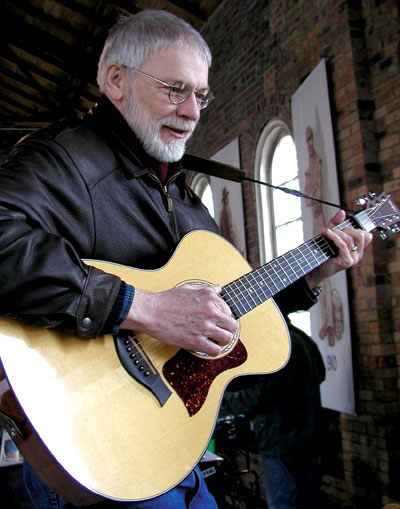Ballads and Blues Course Explores Poetry of Lyrics, Music

Philip E. Smith’s Ballad and Blues class has been a staple in Pitt’s Department of English course offerings since the mid-1970s. Smith, a performer who sang folk music and taught guitar during college, proposed the course as part of a curriculum grant to bring new classes to the humanities. The English professor has been teaching Ballads and Blues ever since.
Smith attributes his interest in ballads and blues to the folk revival of the 1960s. He particularly enjoys exploring the poetry of the lyrics and the music.
The tradition of the ballad was brought to the United States by English, Scottish, and Irish immigrants and put into what Smith calls “the great music mixer.” When the Northern European ballads were combined with African American traditions in the United States, a new sound was created.
The English ballad “The Maid Freed From the Gallows” is a case in point, Smith says. In Europe during the 18th century, misdemeanors were often punishable by death unless a fine was paid. In this ballad, the maid didn’t have the money for her fine, but her true love appeared, paid the fine, and saved the maid. Singer-guitarist and songwriter Leadbelly (c.1889-1949), who was born Huddie Ledbetter and whose music helped to inspire the folk and blues revivals of the 1950s and ‘60s, adapted this ballad and recorded it in 1939 as “The Gallis Pole.” The words to one verse:
Friend, did you bring me the silver,
Friend, did you bring me the gold,
What did you bring me my dear friend,
To keep me from the gallows pole.
Students in Smith’s course learn the history and explore the lyrics and music of both adapted and original ballads. Also studied are blues songs, such as “John Henry Blues” by Georgia musician Fiddlin’ John Carson, and others.
“The ballad is the narrative of the story and the blues become the lyric,” explains Smith. Often, he adds, there is an irony to the story as in Big Bill Broonzy’s paradoxical lyric, “lookin’ up at down.”
There are four required texts for Smith’s course, including The Viking Book of Folk Ballads of the English-Speaking World (Viking Press, 1956; rpt. Cathedral Publishing, 1998) and Looking Up at Down: The Emergence of the Blues Culture (Temple University Press, 1989). Students also must complete one independent project, a requirement that Smith says has produced some interesting results. One student, for example, compiled a list of songs from World War II that had been sung by her grandfather during his time with the Officer Training Corps at Pitt. Another student, who had actually had been a hobo and had ridden the rails, wrote about the blues and ballads of railroading.
Other Stories From This Issue
On the Freedom Road

Follow a group of Pitt students on the Returning to the Roots of Civil Rights bus tour, a nine-day, 2,300-mile journey crisscrossing five states.
Day 1: The Awakening
Day 2: Deep Impressions
Day 3: Music, Montgomery, and More
Day 4: Looking Back, Looking Forward
Day 5: Learning to Remember
Day 6: The Mountaintop
Day 7: Slavery and Beyond
Day 8: Lessons to Bring Home
Day 9: Final Lessons

